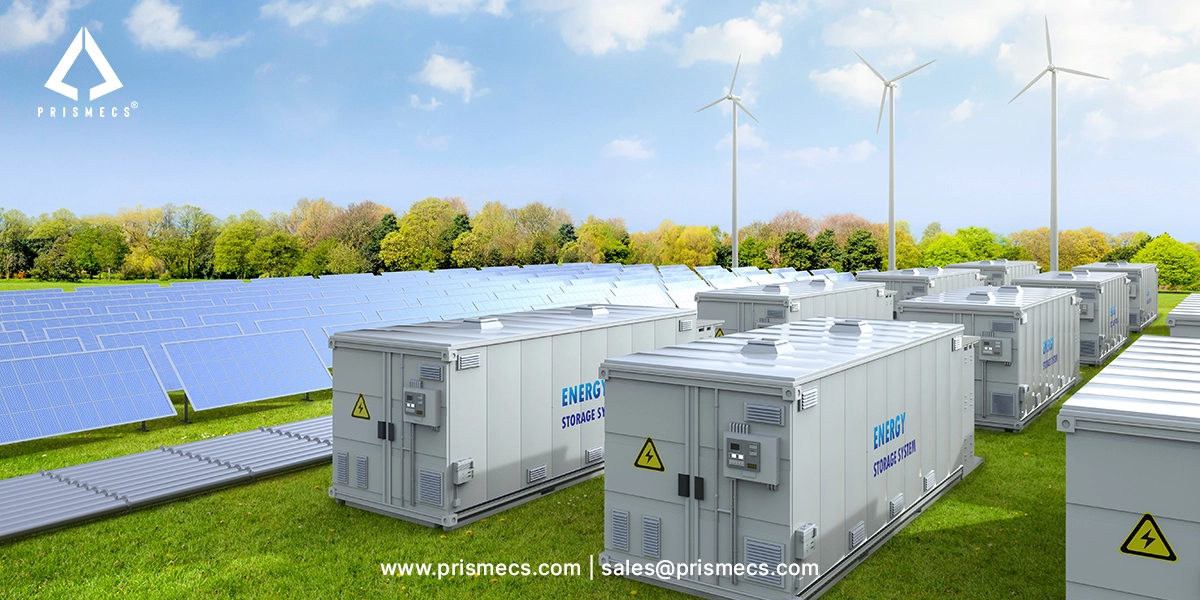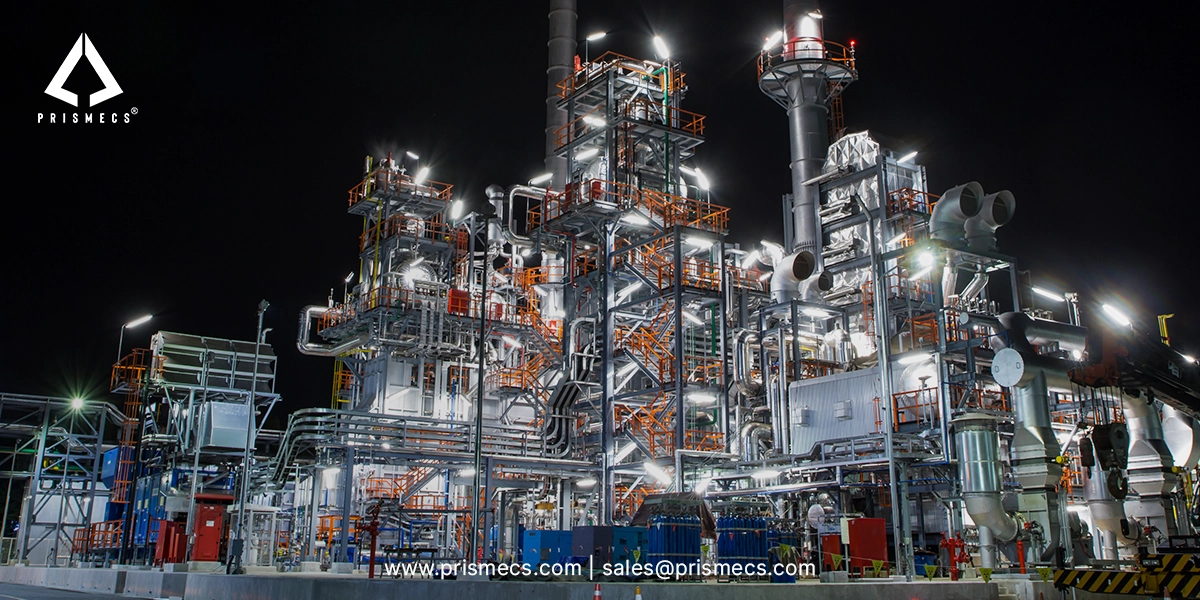
As businesses use more digital tools, cloud services, and AI, they need IT systems that are fast, efficient, and easy to expand. Prismecs sits at the heart of this change. One solution to gain momentum is the Powered Shell Data Center. This blog explores what a powered shell data center means, highlights its benefits, and goes over design essentials.
What is a Powered Shell Data Center?
A Powered Shell Data Center is a basic, ready-made building that already has power systems. Tenants only need to bring and install their own IT equipment like servers, storage, switches, and racks. It’s basically an empty but fully powered space that customers can set up according to their needs.
Shell Data Centers provide the framework: walls, roofs, electrical hookups, and environmental controls. A Powered Shell goes further: it hands over power, cooling, and redundancy, so clients don’t build from zero. This model speeds things up. It lets businesses deploy critical IT infrastructure much more quickly than building a data center entirely from scratch.
Key Benefits :
Below are some of the key benefits of Powered Shell Data Centers:
Speed to Market
Companies need computing infrastructure faster than ever. A Powered Shell Data Center cuts build timelines dramatically. While a full custom build can take 1224 months, a powered shell approach often enables operations within 618 months.
Prismecs helps clients move faster: you provide the power, cooling, and building, and they install their IT equipment when ready. That approach accelerates deployment.
Customizability & Flexibility
Clients get to choose and configure their own critical IT infrastructure inside the shell. They decide on redundancy levels, power densities per rack, and Cooling Systems (air, liquid, immersion). Shell Data Centers allow this kind of tailored to fit out without needing to design the whole building themselves.
Cost Efficiency
A Powered Shell Data Center reduces upfront capital expenses. Builders avoid costs tied to full interior buildout until later. Shell structures and prebuilt power and cooling modules often save money, improve supply chain efficiency, and reduce construction risks.
Scalability
Businesses often don’t need full capacity upfront. With a powered shell, clients can occupy part of the space, install part of the IT load, then expand as needs grow. They can add racks, increase power supply, or boost cooling capacity in phases. That ensures better resource utilization.
Improved Power & Cooling Infrastructure Options
Powered shell data centers have built-in power systems (UPS, backup generators, switchgear). They have ready-to-use cooling, which lets you install newer, more efficient cooling systems. High-density racks, immersion cooling, liquid cooling, or hybrid systems become possible when power and space provisions already exist.
Risk Reduction and Regulatory Compliance
Shell models help meet local codes, energy efficiency standards, and redundancy requirements. Having the external shell and power/cooling footprint already designed to meet regulations lessens risk.
The environmental regulations push towards greener power and cooling. So having infrastructure in place that allows for energy efficient cooling, possibly renewable power integration, gives firms an edge.
Key Design Components of a Powered Shell Data Center
To realize those benefits safely and effectively, design matters. Prismecs, as a power and energy specialist, will focus on several essential parts of the design.
The Shell Structure
- To realize these benefits safely and effectively, thoughtful and strategic design is essential. Several key factors need to be considered to ensure the shell structure remains resilient. They adapt as operational needs change.
- Build a robust physical shell: walls, roof, flooring, drainage, fire protection, environmental sealing.
- Provide modular design so that expansion (both floor space and height) is possible.
- Structural design must support heavy racks, cable trays, cooling piping, and mechanical loads.
Power Infrastructure
A reliable and scalable power infrastructure is critical for maintaining continuous operations and supporting high-performance equipment. Efficient design must address both current power needs and future scalability, with built-in redundancy and sustainability in mind.
Electrical Distribution
Includes feeders from local grids, switchgear, and substations.
Uninterruptible Power Supply (UPS):
Crucial for maintaining uptime. Enabled shells often include UPS racks or space allocated for them.
Backup Generators:
Diesel, gas turbines, or alternatives as redundant.
High Power Density Provisioning:
Ensure sufficient capacity per rack (50kW or more in hyperscale cases) if needed.
Renewable Energy Integration:
Solar, wind, or purchasing renewable power helps reduce operational carbon footprint.
Cooling Systems
Heat removal becomes a major concern as racks get denser. Powered Shell Data Centers must prepare for flexible cooling systems, including:
Air Cooling:
Traditional CRAC/CRAH systems; efficient in moderate climates.
Liquid Cooling:
Inrow, rack level, or direct chip, for high densities.
Immersion Cooling:
Submerging server components in dielectric fluids to carry heat away exceptionally efficiently. Big gains in energy efficiency here.
Hybrid Cooling or Free Cooling:
Using ambient air, seasonal differences, and economizers. Also, design shells with sufficient space, ducting, airflow paths, exhaust systems, redundancy in mechanical systems, and access for maintenance.
Environmental & Safety Systems
Protecting both equipment and personnel requires a comprehensive approach to environmental and safety design. These systems must be reliable, scalable, and compliant with industry standards to ensure operational continuity and risk mitigation.
- Fire suppression and smoke detection.
- Physical security: perimeter, access control, surveillance.
- Environmental controls: humidity, temperature.
Network / Connectivity Readiness
While not always part of a powered shell, smart design plans ahead for seamless connectivity. Anticipating future network demands ensures easier upgrades and faster deployment.
- Pre-defined fiber entry points for streamlined installation
- Structured cabling pathways to support organized data flow
- Dedicated space for network and telecom equipment
- Redundant connectivity (e.g., dual fiber routes, multiple carriers) for uptime assurance
- Support for low-latency, high-bandwidth operations to enable scalability and performance
Adoption Trends & Market Drivers
Research shows that by 2030, data centers around the world will need about $6.7 trillion to meet the growing demand for computing power. About $5.2 trillion of this will go toward building data centers that can handle AI workloads. Also, roughly $1.5 trillion will be needed for traditional IT data centers. Overall, that’s nearly $7 trillion in capital outlays needed by 2030, a staggering number by any measure.
Some powered shell models facilitate deployment timelines of 918 months from construction to full operational readiness. Projects increasingly include immersion cooling. In Saudi Arabia, Shell PLC partners to build immersion cooled data centers in Riyadh and Jeddah. They support high-performance workloads.
What pushes businesses toward Powered Shell Data Centers?
Rapid Growth in Data Demand and Cloud / AI / Edge
The need for high performance, low latency, and massive computer demand drives new data center footprints. Companies cannot wait for long lead times. Powered shells give them agility.
Hyperscale & Big Tech Investment
Major cloud providers and hype scale's (AWS, Microsoft Azure, Google, etc.) increasingly use powered shells. Because of quickly rolling out infrastructure in target regions. They want consistency in power delivery, high power density, yet the ability to customize cooling.
Sustainability & Cooling Efficiency Pressure
Regulators, consumers, and energy costs force data centers to be more efficient. Powered shell allows for implementing NextGen cooling systems (immersion, liquid, hybrid) more cleanly. Also integrating renewable power and reducing PUE.
Market for Colocation & Data Sovereignty
Enterprises that don’t want to own full data centers look for colocation providers who offer powered shell spaces. Regulations that require data to stay within certain regions. Also, force organizations to build locally and powered shells to make it easier for them to do that.
Cost & Risk Management
Supply chain issues, inflation, and higher material costs make early preparation of the shell, power, and cooling systems important. It helps companies reduce risks and control their spending more easily.
Fuel Cell For Data Center Market Size
The global market for fuel cells in data centers is growing. Businesses need clean, reliable, and uninterrupted power for critical operations. As companies focus more on sustainability, they are adopting fuel cells because they cut carbon emissions. The market is projected to expand at a robust CAGR of 15.5% from 2025 to 2035, rising from USD 206.3 million in 2025 to USD 869.7 million by 2035.
Challenges & Considerations
While a Powered Shell Data Center offers many benefits, designers and adopters should watch out for some challenges:
- Ensuring the shell design anticipates future needs (so that expansions, power upgrades, cooling enhancements remain possible).
- Balancing upfront investment with interior customization costs. A poorly designed power infrastructure or insufficient cooling provision can bottleneck performance later.
- Local regulations or grid constraints: power availability; permit processes can delay even shell builds.
- Site selection: real estate, connectivity, availability of water for cooling (if needed), climate factors.
- Choose your cooling system based on climate and rules. In very hot, humid areas or where regulations are strict, you need highly efficient cooling or alternative solutions.
Why Powered Shell? | Business Benefits at a Glance
Powered shell data centers offer a strategic path to accelerate infrastructure deployment while reducing capital expenditure. With a building that already has power and cooling, firms can quickly install their IT equipment and start making money. This model delivers the speed, flexibility, and efficiency modern digital operations require.
Key Benefit | Description |
Speed to Market | Go live in 6–12 months vs. 18–36 months for full builds |
Lower CAPEX | Defer interior fit-out costs until IT deployment is needed |
Custom Infrastructure | Tailor IT, power density, redundancy, and cooling to workload |
Energy Efficiency | Integrate liquid or immersion cooling, optimize PUE from Day One |
Risk Reduction | Avoid delays with pre-engineered MEP systems |
Scalability | Expand in phases without redesigning core systems |
Best Practices for Prismecs & Clients
If you plan, build, or invest in a Powered Shell Data Center, follow these practices to maximize value:
Plan Power & Cooling Headroom
Design power infrastructure with margin: ensure UPS, backup generators, feeders, cabling support future higher power density per rack. For Cooling Systems, reserve capacity for cooling expansion or high-density racks.
Use Modular Components
Prefab power modules, modular cooling, standard shell modules to cut construction time, reduce cost, and improve quality.
Efficient Cooling Technologies
Early decisions about immersion cooling or liquid cooling payoff: lower power consumption, better thermal management, lower operational cost. Don’t let cooling become a bottleneck.
Renewable Energy & Efficiency Metrics
Where possible, include solar, wind, or purchase green energy. Monitor metrics like PUE (Power Usage Effectiveness), water usage effectiveness. These help with sustainability compliance and cost savings.
Security, Redundancy & Compliance
Plan for redundancy in both power (backup, redundant feeds) and cooling. Built in security for the shell envelope and interior. Ensure design meets local regulations on power, fire, building codes, data protection, environmental concerns.
Right Location
Choose sites with a reliable power grid, strong connectivity, access to cooling water or a climate. Because it helps with cooling, favorable regulations, and enough space to grow.
Adoption Use Cases | Who's Building Powered Shells?
Powered Shell Data Centers are gaining traction across industries that demand speed, scalability, and efficiency. Hyperscale companies, telecom providers, banks, and colocation operators are using this model. This sets up high-performance infrastructure faster, while keeping control over IT setup and meeting sustainability goals.
Industry | Why Powered Shell Works |
Hyperscale Cloud | Speed to market, scalable IT loads, renewable energy integration |
Telecom & 5G | Low-latency regional hubs, flexible cooling for edge sites |
Financial Services | High compliance, low tolerance for downtime, data sovereignty |
Healthcare | Secure and scalable infrastructure for electronic health records (EHR) |
Colocation Providers | Faster onboarding of tenants, lower upfront investment |
Why Powered Shell Data Centers Matter Now
Powered Shell Data Centers align with current business and energy trends:
- The demand for AI, IoT, edge computing, and big data is pushing Critical IT Infrastructure to scale rapidly.
- Energy costs and efficiency concerns force better design of power infrastructure and cooling systems.
- Companies want to reduce time to market. A powered shell lets them focus on deploying their applications rather than building everything from the ground up.
- Sustainability goals (net zero, carbon footprint, efficient cooling) demand smarter infrastructure. Powered shells make it easier to integrate new cooling technology, greener energy, and efficiency upgrades.
At the Bottom Line
Powered shell data centers offer a strong model for organizations that need fast deployment, customizability, and efficient infrastructure. With the right design—strong building structure, reliable power, and modern cooling. The powered shells provide IT infrastructure that can handle performance, growth, and sustainability needs. We can help you see if a powered shell fits your plan. If you need to set up IT capacity quickly, save costs, and ensure high reliability, a powered shell could be the best solution.
Partner with Prismecs for Expert Services:
Prismecs brings unmatched expertise in power infrastructure, cooling systems, and turnkey data center solutions. From initial design to full deployment, we ensure your powered shell data center is optimized for speed, scalability, and efficiency. Partner with us to build smarter, reduce risk, and accelerate your infrastructure goals with confidence. We are a leading provider of data center energy optimization solutions. To avail of our data center services, call us at +1 (888) 774-7632 or email us at sales@prismecs.com.
Frequently Asked Questions
1. What is a powered shell data center?
A powered shell data center is a pre-built facility with essential power, cooling, and structural infrastructure. It allows faster deployment and customizable interior spaces for specific IT needs.
2. What are the main benefits of powered shell data centers?
Powered shell data centers provide faster build times, lower upfront costs, and flexible customization, supporting scalability and sustainability for cost-effective, adaptable solutions.
3. How does the design of a powered shell data center differ from a traditional data center?
Powered shell data centers supply key power and cooling infrastructure upfront but leave interiors unfinished, letting tenants customize equipment setup for greater flexibility and faster deployment.
4. Which industries commonly adopt powered shell data centers?
Industries like cloud services, finance, healthcare, and large enterprises adopt powered shell data centers for their scalable, customizable, and fast-to-deploy solutions.
5. Are powered shell data centers cost-effective compared to traditional buildings?
Yes. Powered shell data centers save money upfront by putting in the main infrastructure first and leaving the inside for later.
Tags: Powered Shell Data Centers Data Center Design IT Infrastructure Cloud & AI Readiness Energy Efficiency Rapid Deployment
recent posts

EPC Services
7 minutes read
EPC Power: From Design to Delivery of Reliable Energy System
Discover how EPC power solutions streamline design to delivery, ensuring reliable, efficient, and future-ready energy systems in one integrated proces...

Data Centers
12 minutes read
Powered Shell Data Centers | Benefits, Design & Adoption
Discover the benefits, design, and adoption of powered shell data centers. Learn how they boost speed to market, scalability, and energy efficiency.

Distributed Energy Services
9 minutes read
Smart Grid and Distributed Energy Resources
Discover how smart grids and distributed energy resources (DER) work together to create efficient, resilient, and sustainable energy systems for the f...

Petrochemicals
8 minutes read
Petrochemical Plant Operations Explained
Discover how petrochemical plant operations work, from raw material processing to product output. Learn key processes, safety, and technologies involv...